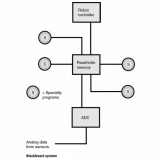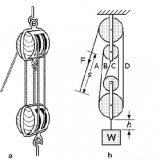Robotic Mechanisms – NON CIRCULAR GEARS 51041
A non-circular gear (NCG) is a special gear design with special characteristics and purpose. While a regular gear is optimized to transmit torque to another engaged member with minimum noise and wear and with maximum efficiency, a non-circular gear’s main objective might be ratio variations, axle displacement oscillationsand more. Common applications include textile machines, potentiometers, CVTs (continuously variable transmissions), window shade panel drives, mechanical presses and high torque hydraulic engines.
A regular gear pair can be represented as two circles rolling together without slip. In the case of non-circular gears, those circles are replaced with anything different from a circle. For this reason NCGs in most cases are not round, but round NCGs looking like regular gears are also possible (small ratio variations result from meshing area modifications).
Generally NCG should meet all the requirements of regular gearing, but in some cases, for example variable axledistance, could prove impossible to support and such gears require very tight manufacturing tolerances and assembling problems arise. Because of complicated geometry, NCGs are most likely spur gears and molding orelectrical discharge machining technology is used instead of generation.
The Non circular plays a critical role in any type of application they are put into, but often their critical importance gets overlooked. It has been seen that the Non Circular Gears can display numerous kinds of unusual motion or speed characteristics. What makes the non circular gears unique is the fact that through the Cams or linkages can also provide these special types of motion requirements, but with non circular gears a more simpler, compact, accurate solution can easily be worked out.
Functions Performed by Non circular Gears
Some of the very common requirements that are effectively handled by non-circular gears consist the following:
» Variable Speed: Conversion of an uniform input speed into a variable output speed.
» Constant Speed Segments: Providing many types of constant-speed segments on an ongoing operating cycle.
» Combined rotation and translation.
» Stop-and-dwell motion.Types of Non Circular Gears
Actually the type of Non circular Gears is dependent on the type of speed they deliver. On that premise Gears can be of the types that producing Variable speed. Gears With constant speed segments. Those for combined rotation and translation and finally that with stop-and-dwell motion.
Elliptical Gears : Elliptical gears can generate a variable output speed. A set of identical elliptical gears has been seen to run at an uniform center distance, but delivers a changing output speed as they rotate. Elliptical Gears can come in two basic shapes.
Elliptical Gears can come in two basic shapes.
1- Unilobe Gears. The image of which is shown below. Unilobe elliptical gears generally rotates about in one of the two fixed points on its axis.
2 -Bilobe Gears. The Bilobe elliptical Gears is found to be rotating about its center.
As is seen from the graph, there is a variation in the speed-reduction ratio of these gears. It is varying from 1/K to K for each cycle of the rotation. The practical value of K ranges up to 3. In the image shown above, with the rotation of the gears the radii of both the driving and driven gears change. Consequently there is first a decrease in the speed for 1/4 revolution, then there is increase for 1/4 revolution, so on. These recurring periods of speed increase or decrease takes place four times per revolution.
Triangular Gears : A pair of triangular gears generally has three lobes, or high points on the perimeter as compared to the two lobes in the elliptical bilobe gears. As a result triangular gears produces a total of six periods increase or decrease of speed per revolution in comparison to the four in bilobe gears. But they have a comparatively smaller range of speed ratio than the elliptical gears.
Square Gears : Square Gears are another way of producing variable speed. Square Gears have four lobes. As a result, they deliver eight periods of increase or decrease in speed per revolution. The Square Gears also have a smaller range of speed ratio than the elliptical gears.
Non circular Gears with constant-speed segments
In this category where the application requires numerous constant-speed segments within a cycle, there is multispeed gears, perfectly suitable for the job.
Multispeed Gears : The Multi speed Gears are designed in a manner to work in cases where there is requirement of several constant speed segments. Multi speed Gears delivers one uniform speed for part of a cycle and a different speed for the second part of the cycle. They can make a perfect transition between the speeds. It does so by unique function segments between constant speed sections of a gearing sequence. Typically, Multispeed gear pairs consists of sinusoidal transitions and are not similar.
However, similar input and output gearing can be achieved with help of elliptical transitions.
Non circular Gears for with rotation and translation
For application that requires both translational and rotational motion, there are certain gears that serve as a proper cam substitutes.
Cam Gears : Cam Gears are often applied for use in labeling machines Cam gears copies the shape of a part that requires labeling and a cam-following rack generally carries the labeling equipment at a constant surface speed. In the welding applications, where a cam gear is used for simulating the shape of a part that is to be welded and a follower is used to carry a welding torch at an uniform speed for a smooth welding.
TECHNICAL DETAILS OF NON CIRCULAR GEARS
Download This PDF – 51041-Technical-Details-Of-Non-Circular-Gears.pdf





